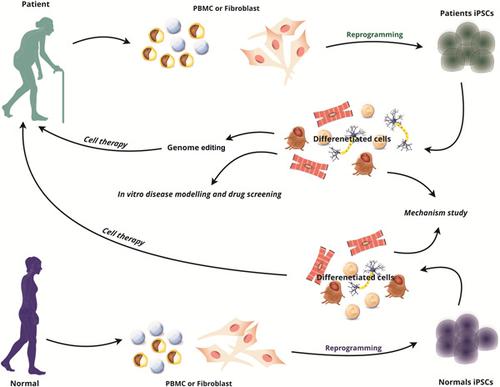当前位置:
X-MOL 学术
›
J. Cell. Physiol.
›
论文详情
Our official English website, www.x-mol.net, welcomes your feedback! (Note: you will need to create a separate account there.)
Induced pluripotent stem cells (iPSCs) as game-changing tools in the treatment of neurodegenerative disease: Mirage or reality?
Journal of Cellular Physiology ( IF 5.6 ) Pub Date : 2020-05-21 , DOI: 10.1002/jcp.29800 Niloufar Yousefi 1, 2 , Shahla Abdollahii 3 , Mohammad Amin Jadidi Kouhbanani 2, 4 , Ali Hassanzadeh 2, 5, 6
Journal of Cellular Physiology ( IF 5.6 ) Pub Date : 2020-05-21 , DOI: 10.1002/jcp.29800 Niloufar Yousefi 1, 2 , Shahla Abdollahii 3 , Mohammad Amin Jadidi Kouhbanani 2, 4 , Ali Hassanzadeh 2, 5, 6
Affiliation

|
Based on investigations, there exist tight correlations between neurodegenerative diseases' incidence and progression and aberrant protein aggregreferates in nervous tissue. However, the pathology of these diseases is not well known, leading to an inability to find an appropriate therapeutic approach to delay occurrence or slow many neurodegenerative diseases' development. The accessibility of induced pluripotent stem cells (iPSCs) in mimicking the phenotypes of various late‐onset neurodegenerative diseases presents a novel strategy for in vitro disease modeling. The iPSCs provide a valuable and well‐identified resource to clarify neurodegenerative disease mechanisms, as well as prepare a promising human stem cell platform for drug screening. Undoubtedly, neurodegenerative disease modeling using iPSCs has established innovative opportunities for both mechanistic types of research and recognition of novel disease treatments. Most important, the iPSCs have been considered as a novel autologous cell origin for cell‐based therapy of neurodegenerative diseases following differentiation to varied types of neural lineage cells (e.g. GABAergic neurons, dopamine neurons, cortical neurons, and motor neurons). In this review, we summarize iPSC‐based disease modeling in neurodegenerative diseases including Alzheimer's disease, amyotrophic lateral sclerosis, Parkinson's disease, and Huntington's disease. Moreover, we discuss the efficacy of cell‐replacement therapies for neurodegenerative disease.
中文翻译:

诱导多能干细胞(iPSC)作为改变神经退行性疾病的游戏规则的工具:幻影还是现实?
根据调查,神经退行性疾病的发生和发展与神经组织中异常的蛋白聚集调节密切相关。然而,这些疾病的病理学还不为人所知,导致无法找到合适的治疗方法来延迟发生或延缓许多神经退行性疾病的发展。在模拟各种迟发性神经退行性疾病的表型方面,诱导性多能干细胞(iPSC)的可及性为体外疾病建模提供了一种新策略。iPSC为澄清神经退行性疾病的机制提供了宝贵的且广为人知的资源,并为药物筛选准备了有前途的人类干细胞平台。无疑,使用iPSC进行神经退行性疾病建模已经为机械类型的研究和新型疾病治疗的识别建立了创新机会。最重要的是,在分化为各种类型的神经谱系细胞(例如GABA能神经元,多巴胺神经元,皮层神经元和运动神经元)后,iPSC被认为是用于神经退行性疾病的基于细胞治疗的新型自体细胞起源。在这篇综述中,我们总结了基于神经变性疾病的基于iPSC的疾病模型,包括阿尔茨海默氏病,肌萎缩性侧索硬化症,帕金森氏病和亨廷顿氏病。此外,我们讨论了神经退行性疾病的细胞替代疗法的功效。在分化为各种类型的神经谱系细胞(例如,GABA能神经元,多巴胺神经元,皮层神经元和运动神经元)后,iPSC被认为是用于神经退行性疾病的基于细胞治疗的新型自体细胞起源。在这篇综述中,我们总结了基于神经变性疾病的基于iPSC的疾病模型,包括阿尔茨海默氏病,肌萎缩性侧索硬化症,帕金森氏病和亨廷顿氏病。此外,我们讨论了神经退行性疾病的细胞替代疗法的功效。在分化为各种类型的神经谱系细胞(例如,GABA能神经元,多巴胺神经元,皮质神经元和运动神经元)后,iPSC被认为是用于神经退行性疾病的基于细胞治疗的新型自体细胞起源。在这篇综述中,我们总结了基于神经变性疾病的基于iPSC的疾病模型,包括阿尔茨海默氏病,肌萎缩性侧索硬化症,帕金森氏病和亨廷顿氏病。此外,我们讨论了神经退行性疾病的细胞替代疗法的功效。我们总结了在神经退行性疾病(包括阿尔茨海默氏病,肌萎缩性侧索硬化症,帕金森氏病和亨廷顿氏病)中基于iPSC的疾病建模。此外,我们讨论了神经退行性疾病的细胞替代疗法的功效。我们总结了在神经退行性疾病(包括阿尔茨海默氏病,肌萎缩性侧索硬化症,帕金森氏病和亨廷顿氏病)中基于iPSC的疾病建模。此外,我们讨论了神经退行性疾病的细胞替代疗法的功效。
更新日期:2020-05-21
中文翻译:

诱导多能干细胞(iPSC)作为改变神经退行性疾病的游戏规则的工具:幻影还是现实?
根据调查,神经退行性疾病的发生和发展与神经组织中异常的蛋白聚集调节密切相关。然而,这些疾病的病理学还不为人所知,导致无法找到合适的治疗方法来延迟发生或延缓许多神经退行性疾病的发展。在模拟各种迟发性神经退行性疾病的表型方面,诱导性多能干细胞(iPSC)的可及性为体外疾病建模提供了一种新策略。iPSC为澄清神经退行性疾病的机制提供了宝贵的且广为人知的资源,并为药物筛选准备了有前途的人类干细胞平台。无疑,使用iPSC进行神经退行性疾病建模已经为机械类型的研究和新型疾病治疗的识别建立了创新机会。最重要的是,在分化为各种类型的神经谱系细胞(例如GABA能神经元,多巴胺神经元,皮层神经元和运动神经元)后,iPSC被认为是用于神经退行性疾病的基于细胞治疗的新型自体细胞起源。在这篇综述中,我们总结了基于神经变性疾病的基于iPSC的疾病模型,包括阿尔茨海默氏病,肌萎缩性侧索硬化症,帕金森氏病和亨廷顿氏病。此外,我们讨论了神经退行性疾病的细胞替代疗法的功效。在分化为各种类型的神经谱系细胞(例如,GABA能神经元,多巴胺神经元,皮层神经元和运动神经元)后,iPSC被认为是用于神经退行性疾病的基于细胞治疗的新型自体细胞起源。在这篇综述中,我们总结了基于神经变性疾病的基于iPSC的疾病模型,包括阿尔茨海默氏病,肌萎缩性侧索硬化症,帕金森氏病和亨廷顿氏病。此外,我们讨论了神经退行性疾病的细胞替代疗法的功效。在分化为各种类型的神经谱系细胞(例如,GABA能神经元,多巴胺神经元,皮质神经元和运动神经元)后,iPSC被认为是用于神经退行性疾病的基于细胞治疗的新型自体细胞起源。在这篇综述中,我们总结了基于神经变性疾病的基于iPSC的疾病模型,包括阿尔茨海默氏病,肌萎缩性侧索硬化症,帕金森氏病和亨廷顿氏病。此外,我们讨论了神经退行性疾病的细胞替代疗法的功效。我们总结了在神经退行性疾病(包括阿尔茨海默氏病,肌萎缩性侧索硬化症,帕金森氏病和亨廷顿氏病)中基于iPSC的疾病建模。此外,我们讨论了神经退行性疾病的细胞替代疗法的功效。我们总结了在神经退行性疾病(包括阿尔茨海默氏病,肌萎缩性侧索硬化症,帕金森氏病和亨廷顿氏病)中基于iPSC的疾病建模。此外,我们讨论了神经退行性疾病的细胞替代疗法的功效。


























 京公网安备 11010802027423号
京公网安备 11010802027423号